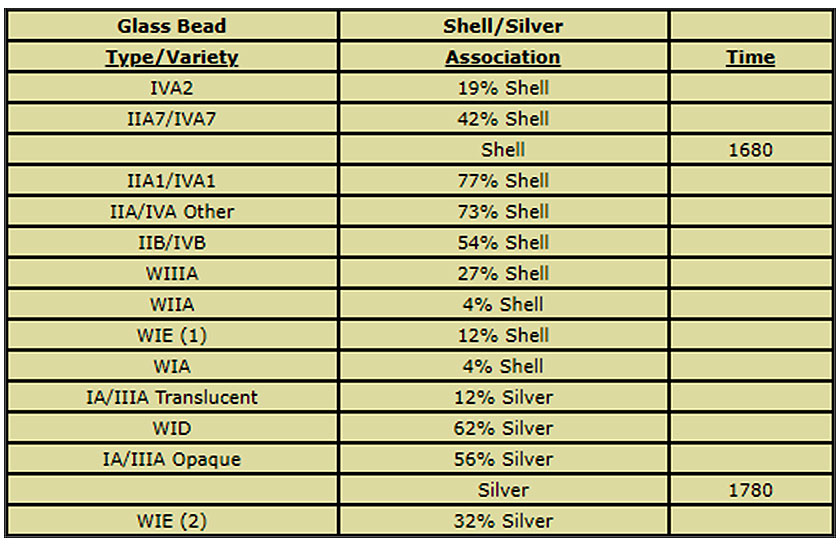
Glass Bead Sequence - A Beginning
There are non-glass bead fields within the database that may provide a first impression of the Chickasaw glass bead sequence - shell and silver. Recall that we earlier presented three Chickasaw produced shell categories-beads, discs and pins. For the moment, we will combine the three shell categories and assume that all three date before the start of sustained trade or 1680.
When we discussed silver ornaments earlier, we noted that Canadian silversmiths dating to the last two decades of the eighteenth century hallmarked most of the datable silver ornaments. For the moment, we will assume the date of silver ornaments in the database as being from the last of the eighteenth century or 1780.
Figures 5 and 6 provide graphs of shell and silver, respectively, with the glass bead fields on a feature basis. Note that these graphs indicate all glass bead feature occurrences, including exclusives and singles.
Figure 5 Shell /Glass Bead Feature Associations
Figure 6 Silver/Glass Bead Feature Associations
On Figure 5, the three categories of shell are graphed collectively. It must be noted that there are 26 shell- bead, disc and/or pin features in the database. Note on Figure 5 that these 26 shell features represent 100% graphically, and that "Shell" is exclusive of "Silver". That is, within the 26 shell features, silver ornaments were not present. Note also that shell has prominent relations with four glass bead fields-IIA1/IVA1 and IIA/IVA Other followed by IIB/IVB and IIA7/IVA7. Among the 26 shell features, IIA1/IVA1 occurred 76.9%.
On Figure 6, the silver database includes 34 features. Note that within the 34 features, silver does not occur with shell discs, beads or pins. Silver occurs predominantly with three glass bead types/varieties- WID, IA/IIIA Opaque and WIE (2). Note there are a number of bead types/varieties that exhibit minor associations, which may be accounted for by heirlooms, a concept we will investigate later.
Comparing the glass bead fields in Figures 5 and 6, note that the glass beads associated prominently with one are not associated with the other. In addition, there are more glass bead types/varieties associated with shell than silver. Further, the glass bead type/variety % associations are higher generally with shell than silver.
Given our assumption that shell predates silver by about 100 years, we may use the two figures to formulate a glass bead sequence.
In addition, given the relative exclusive associations of bead type/variety to either shell or silver, a formative glass bead sequence may be stated. Table 4 presents this sequence.
Table 4 Formative Glass Bead Sequence
Note the Table 4 formative sequence presents two bead types/varieties that predate shell. The position of "Shell" and "Silver" are noted within the sequence on Table 4. Recall that this sequence was developed using the association of 26 features containing both shell beads, discs or pins and another 34 features, exclusive of shell, that contained datable silver ornaments. The shell/silver association represents the graphical values taken from Figures 5 and 6.
The association of the glass bead types/varieties follows, exclusive of shell and silver. Table 4 and the % associations with Silver and Shell will be referred to in the individual glass bead types/varieties associations.


